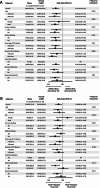Inverse association of obesity with bout periodicity in episodic cluster headache: a multicenter cross-sectional study
- PMID: 40542389
- PMCID: PMC12180171
- DOI: 10.1186/s10194-025-02061-9
Inverse association of obesity with bout periodicity in episodic cluster headache: a multicenter cross-sectional study
Abstract
Background: Cluster headache (CH) is the most painful headache disorder. Despite a large body of evidence on obesity's negative influence on migraine, its impact on cluster headache disease activity remains unexplored. We aimed to determine whether body mass index (BMI) and obesity are associated with lifetime bout occurrence and annual bout frequency in patients with episodic cluster headache (ECH).
Methods: The Korean Cluster Headache Registry (KCHR) is a prospective, multicenter registry of consecutive patients with CH over 4 years. This cross-sectional study included 316 eligible patients with ECH, with ≥ 2 years of duration of CH disease and ≥ 2 times of lifetime bout occurrence. Obesity was determined using the Asia-Pacific classification (obese: BMI ≥ 25.0 kg/m2). Bout frequency was defined as an average annual number of bout occurrence: number of lifetime bout occurrence divided by total duration of CH disease. The main outcomes included odds ratios (ORs) of BMI and obesity for quartiles of lifetime bout occurrence and annual bout frequency by performing ordinal logistic regression analysis.
Results: The mean (SD) age of the patients was 37 (9.7); 50 (15.8%) were female. The mean (SD) BMI was 23.9 (3.2) kg/m2; 105 (33.2%) were obese. The median (interquartile range) duration of CH disease was 10 (6-16) years; lifetime bout occurrence was 7 (4-12); and annual bout frequency was 0.88 (0.5-1.10). In multivariable adjusted models, OR of BMI (per 1 kg/m2) and the obese group for lifetime bout occurrence were 0.89; 95% CI, 0.84-0.95 and 0.40; 95% CI, 0.23-0.68. Age, BMI, and seasonal propensity were associated factors for annual bout frequency. After multivariable adjustment, BMI and obesity were inversely associated with annual bout frequency (BMI per 1 kg/m2 OR: 0.92; 95% CI: 0.86-0.98 and obese OR: 0.52; 95% CI: 0.32-0.86).
Conclusions: BMI and obesity were inversely associated with lifetime bout occurrence and annual bout frequency in ECH, suggesting that neurobiological aspects of obesity may suppress cluster bout periodicity.
Keywords: Body mass index; Cluster headache; Headache; Obesity; Obesity paradox.
© 2025. The Author(s).
Conflict of interest statement
Declarations. Ethics approval and consent to participate: The study protocol was approved by the ethics committee in each participating hospital and complied with the Declaration of Helsinki and Good Clinical Practice guidelines. All patients fully understood the study aims and gave informed written consent before their participation. Consent for publication: Not applicable. Competing interests: The authors declare no competing interests.
Figures


Similar articles
-
Diet, physical activity and behavioural interventions for the treatment of overweight or obese children from the age of 6 to 11 years.Cochrane Database Syst Rev. 2017 Jun 22;6(6):CD012651. doi: 10.1002/14651858.CD012651. Cochrane Database Syst Rev. 2017. PMID: 28639319 Free PMC article.
-
Metformin for women who are overweight or obese during pregnancy for improving maternal and infant outcomes.Cochrane Database Syst Rev. 2018 Jul 24;7(7):CD010564. doi: 10.1002/14651858.CD010564.pub2. Cochrane Database Syst Rev. 2018. PMID: 30039871 Free PMC article.
-
Botulinum toxins for the prevention of migraine in adults.Cochrane Database Syst Rev. 2018 Jun 25;6(6):CD011616. doi: 10.1002/14651858.CD011616.pub2. Cochrane Database Syst Rev. 2018. PMID: 29939406 Free PMC article.
-
Drugs for preventing postoperative nausea and vomiting in adults after general anaesthesia: a network meta-analysis.Cochrane Database Syst Rev. 2020 Oct 19;10(10):CD012859. doi: 10.1002/14651858.CD012859.pub2. Cochrane Database Syst Rev. 2020. PMID: 33075160 Free PMC article.
-
Hormonal contraceptives for contraception in overweight or obese women.Cochrane Database Syst Rev. 2016 Aug 18;2016(8):CD008452. doi: 10.1002/14651858.CD008452.pub4. Cochrane Database Syst Rev. 2016. PMID: 27537097 Free PMC article.
References
-
- Petersen AS, Lund N, Goadsby PJ, Belin AC, Wang SJ, Fronczek R et al (2024) Recent advances in diagnosing, managing, and Understanding the pathophysiology of cluster headache. Lancet Neurol 23(7):712–724 - PubMed
-
- Kim M, Yu JK, Kim YH (2024) Update on cluster headaches: from genetic to novel therapeutic approaches. Headache Pain Res 25(1):42–53
-
- Schor LI, Pearson SM, Shapiro RE, Zhang W, Miao H, Burish MJ (2021) Cluster headache epidemiology including pediatric onset, sex, and ICHD criteria: results from the international cluster headache questionnaire. Headache 61(10):1511–1520 - PubMed
-
- Nesbitt AD, Goadsby PJ (2012) Cluster headache. BMJ 344:e2407 - PubMed
Publication types
MeSH terms
LinkOut - more resources
Full Text Sources
Medical

